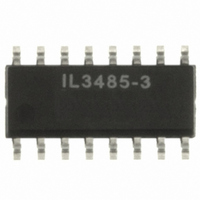IL3485-3E NVE, IL3485-3E Datasheet - Page 9

IL3485-3E
Manufacturer Part Number
IL3485-3E
Description
TXRX ISO BUS 20MBPS RS485 16SOIC
Manufacturer
NVE
Series
IsoLoop®r
Datasheet
1.IL3422-3E.pdf
(15 pages)
Specifications of IL3485-3E
Inputs - Side 1/side 2
RS-485
Number Of Channels
1
Isolation Rating
2500Vrms
Voltage - Supply
4.25V, 5V
Data Rate
20Mbps
Propagation Delay
55ns
Output Type
Logic
Package / Case
16-SOIC (3.9mm Width)
Operating Temperature
-40°C ~ 85°C
Lead Free Status / RoHS Status
Lead free / RoHS Compliant
Other names
390-1128-5
Available stocks
Company
Part Number
Manufacturer
Quantity
Price
Part Number:
IL3485-3E
Manufacturer:
NVE
Quantity:
20 000
Applications Information
RS-485 and RS-422 are differential (balanced) data transmission standards for use over long distances or in noisy environments.
RS-422 is an RS-485 subset, so RS-485 transceivers are also RS-422-compliant. RS-422 is a multi-drop standard allowing only
one driver and up to 10 receivers on each bus (assuming unit load receivers). RS-485 is a true multipoint standard which allows up
to 32 unit load devices (any combination of drivers and receivers) on each bus. To allow for multipoint operation, RS-485 requires
drivers to handle bus contention without damage. Another important advantage of RS-485 is the extended common-mode range
(CMR), which requires driver outputs and receiver inputs withstand +12 V to −7 V. RS-422 and RS-485 are intended for runs as
long as 4,000 feet (1,200 m), so the wide CMR is necessary for ground potential differences, as well as voltages induced in the
cable by external fields.
Receiver Features
IL3000 transceivers have differential input receivers for maximum noise immunity and common-mode rejection. Input sensitivity
is ±200 mV as required by the RS-422 and RS-485 specifications. The receivers include a “fail-safe if open” function that
guarantees a high level receiver output if the receiver inputs are unconnected (floating). Receivers easily meet the data rates
supported by the corresponding driver. IL3000-Series receiver outputs have tri-state capabilities with active low RE inputs.
Driver Features
The RS485/422 driver is a differential output device that delivers at least 1.5 V across a 54 Ω load (RS-485), and at least 2 V
across a 100 Ω load (RS-422). The driver features low propagation delay skew to maximize bit width and minimize EMI. IL3222
and IL3285 drivers have tri-state capability with an active high DE input.
Cabling, Data Rate and Terminations
Cabling:
Use twisted-pair cable. The cable can be unshielded if it is short (<10 m) and the data rate is slow (<100 Kbps). Otherwise, use
screened cable with the shield tied to earth ground at one end only. Do not tie the shield to digital ground. The other end of the
shield may be tied to earth ground through an RC network. This prevents a DC ground loop in the shield. Shielded cable
minimizes EMI emissions and external noise coupling to the bus.
Data Rate:
The longer the cable, the slower the data rate. The RS-485 bus can transmit ground over 4,000 feet (1,200 m) or at 10Mbps, but
not both at the same time. Transducer and cable characteristics combine to act as a filter with the general response shown in
Figure 4. Other parameters such as acceptable jitter affect the final cable length versus data rate tradeoff. Less jitter means better
signal quality but shorter cable lengths or slower data rates. Figure 4 shows a generally accepted 30% jitter and a corresponding
data rate versus cable length.
NVE Corporation
Figure 4. Cable Length vs. Data Rate (30% jitter).
11409 Valley View Road, Eden Prairie, MN 55344-3617
Cable Length (feet)
4000
1000
100
40
100
1K
Data Rate (bps)
10K
Phone: (952) 829-9217
9
100K
1M
Fax: (952) 829-9189
10M
IL3485/IL3422
www.IsoLoop.com
©NVE Corporation

















